
Functions of more variables are a natural generalization of functions of one variable. A function of one variable is a mapping from one copy of real numbers (typically from some subset) to another copy. We obtain a function of more variables when we replace the starting one-dimensional set with a set of more dimensions.

People usually think of a formula when talking about functions (which is not
always possible, but we typically meet them this way), and this also allows
for a logical extension: from formulas of the type
![]() ).
).
In this notation, our work with functions of more variables is often analogous to the case of one variable. Many ideas carry over, just calculations and procedures are sometimes a bit more complicated. All this is markedly easier if we can connect theoretical ideas with geometrical imagination, here some experience with basic objects in more-dimensional space (lines, planes) comes handy.
This is also the main aim of these pages, to show the geometry behind notions, calculations and procedures. We start with the definition of a function of more variables to put our reasoning on firm footing.
Definition.
By a function of more variables we mean any mappingf : D ↦ ℝ, whereD = D( f ) is some subset ofℝn. If D is not explicitely given, then for the domain
D( f ) we take the set of allfor which ∈ℝn
f ( makes sense.)
When a function is given by a formula, we determine its domain just like with functions of one variable: We ask what restrictions for the variables arise from that given formula.
Unlike the case of one variable, we need not try to express the resulting set in some standard way (union of intervals), since this is simply not possible in more dimensions; sets come in so many shapes that we are not able to write them down using one basic type of set (or several basic types). Thus it is enough to write the answer as
![]() ∈ℝn; conditions for
∈ℝn; conditions for ![]() }.
}.
Conversely, there is one new thing that does not make much sense in one dimension: In more dimensions we can sometimes recognize what kind of object it is.
Example.
We determine
a)
b) ![]() :
:
it is a circle centered at the origin, with radius 3.
c) ![]() :
:
it is a ball centered at the origin, with radius 3.
d)  :
:
it is the plane with a line---the main diagonal---removed (see picture below).
e) ![]() :
:
it is the first and third closed quadrant in the plane.
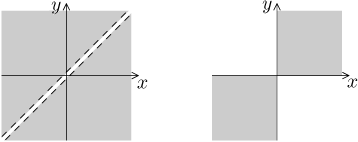
We usually visualise functions of one variable through its graph.
Generalizing this notion to more dimensions is easy. In one variable, the
graph of a function is a subset of the two-dimensional space determined as
the set of all points of the form
![]() )
)![]() ))∈ℝn+1,
))∈ℝn+1,![]() = (x1,...,xn).
= (x1,...,xn).
When

If we do this at all points of the domain, the corresponding dots create a
certain object that we can imagine to be a sort of wavy surface. This is
what in fact happens with functions of two variables, a typical graph of
such a function is some thin (essentially two-dimensional) object inside a
three-dimensional space. With a bit of luck we can get a very suggestive
picture of it using shading and similar methods. For instance, the graph of
a constant function
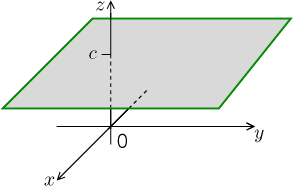
We like to work with functions of two variables precisely because we can
usually sketch them. Experience should suggest that there also are functions
of two variables whose graphs are not that nice, it could be just some
scattered bunch of points in
If we have three or more variables, then we cannot even sketch a likeness of a graph, four-dimensional space is beyond our imagination. People then employ other means that would allow us to get a visual feeling for a function's behaviour. We will show here the most popular approaches.
It should be noted that these methods are also useful for the case
There are also other methods for obtaining sketches of functions of two variables, notably using appropriate programs (Maple, Mathematica and such), which is convenient and nice. However, it is useful to understand things well, after all, those programs sometimes fail and then we have to rely on the good old brain and our knowledge.
This is one of the most powerful visualisation methods, but this notion also has a wider use, for instance when investigating objects that were defined implicitly.
Definition.
Letf: D( f ) ↦ ℝ be a function, whereD( f ) ⊆ ℝn. Forc∈ℝ we define the corresponding level sets
Lc = { ∈D( f ); f (
) = c}.
How does it work? First we slice the graph at level c (we ask where the values of the function are equal to c) and then we check for which values of variable we get there, that is, we project that cut into the domain. If we imagine the graph to be a tract of land, then level sets are places given by their geographical coordinates (that is, places on a map) on which the elevation is precisely c. In other words, level sets are analogous to contours on a map. An experienced tourist can guess the shape of land just by looking at contours, similarly we can deduce a lot of useful information from level sets.
When working with functions of two variables, we traditionally say level curves instead of sets, and with three variables we often say level surfaces.
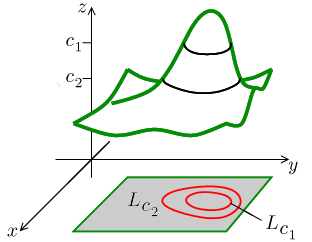
From the definition we see that

Slices are a simple but very powerful tool for exploring more-dimensional situations. However, they will be really simple for us only if we understand well the interplay between formulas and geometric meaning. The basic idea is that we create a two-dimensional "slice" of a multi-dimensinal situation by cutting it with a plane. Such a slice can be (hopefully) explored using tools for investigating (graphs of) functions of one variable.
Assume we are in a situation when the variables are taken from the world of
![]() and
consider a straight line p in
and
consider a straight line p in
![]() . Points of this line are
given (if we assume uniform movement) by the parametric equation
. Points of this line are
given (if we assume uniform movement) by the parametric equation
![]() =
= ![]() + t
+ t![]() ,
,![]() +t
+t![]() )
)![]() +t
+t![]() )
)
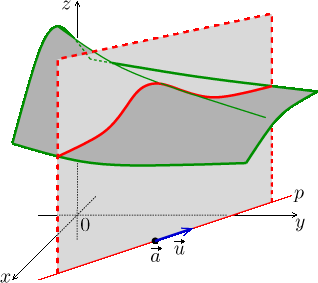
The shape of this slice is obviously related to the function
![]() +t
+t![]() ),
),![]() +
+ ![]() ,
,![]() in our original many-dimensional
picture of the graph of f. The amount of distortion obviously depends on
the size of the directional vector
in our original many-dimensional
picture of the graph of f. The amount of distortion obviously depends on
the size of the directional vector
![]() , which should not
surprise: The
faster we go, the more the landscape around gets subjectively distorted
(it get "squeezed", we pass things quicker).
Therefore we prefer directional vectors of magnitude one (unless the
situation we are in prevents us, for instance when we are working with some
applications), then the geometric information agrees.
We will encounter
these considerations again in the section on derivatives.
, which should not
surprise: The
faster we go, the more the landscape around gets subjectively distorted
(it get "squeezed", we pass things quicker).
Therefore we prefer directional vectors of magnitude one (unless the
situation we are in prevents us, for instance when we are working with some
applications), then the geometric information agrees.
We will encounter
these considerations again in the section on derivatives.
Example
Consider the function
![]()
We will investigate the slice through its graph that we obtain by cutting it
with the plane above the line
The description of the line yields formulas
![]()
The last expression shows that the graph of the function
φ
is shaped
like a hill whose summit (maximum) is at time
![]() || = ||(−1,1)||
|| = ||(−1,1)||
We remark that this need not necessarily mean that the graph of the function
f as such has a hill there. To see a situation of this sort, look at the
picture above. The graph there is not exactly like our f, but the
situation fits quite well: We cut through a sloping landscape and get a hill
on the slice. The picture even has the point ![]() , vector
, vector ![]() and line
p at the right places and the shape of the slice is essentially correct.
and line
p at the right places and the shape of the slice is essentially correct.
We also remark that if we wanted to see the precise shape of the slice, or if we wanted to work analytically with its geometry, we would have to consider the directional vector
![]()
The calculations are then analogous, just a bit less pleasant.
We prefer to work with lines parallel to coordinate axes, since then we get
information that is easy to handle both graphically and analytically (we see
the influence of individual variables). For instance, if we are in
This idea can be generalized as follows: We fix a certain number of
variables and move with the others, which allows us to lower the number of
dimensions we work with, depending on what we are currently interested in.
Consider a function
![]() = (x0, y0,z0).
= (x0, y0,z0).
If we fix values
![]() in the direction
of the x-axis,
and as we go along, we see the temperatures. It is a one-dimensional
situation
in the direction
of the x-axis,
and as we go along, we see the temperatures. It is a one-dimensional
situation
If we fix only the variable
![]() perpendicular to the z-axis. Thus we obtain a function of two variables
perpendicular to the z-axis. Thus we obtain a function of two variables
In this way we get another tool for investigating functions. Still, most often we work with movement along a line and one-dimensional situations.
When working with functions of one variable, we often think of its graph as
an analytical object in the plane given by the equation
For functions of n variables we obtain an object in
![]() ).
).
Sometimes we have to reorganize the equation we obtain, but then we have to
be careful about changing the resulting set. This is actually nothing new,
we had to be careful already when working with functions of one variable.
For instance, we know how the graph of the function
![]()
![]()
![]()
Such change in size of a set (getting larger or smaller) happens when we use some non-equivalent steps when rewriting our equation, the squaring that we used above is one popular case. Experience should suggest when it is time to pay extra attention.
In order to be sussessful in recognizing shapes we need to know basic geometric objects. The most popular are flat objects (lines, planes) and objects given by quadratic equations, which in two dimensions means the well-known family of conic sections (parabola, circle and, more generally, an ellipse), in more dimensions we get a richer family. It seem clear that one would have to be really lucky to hit one of the few known equations when choosing from infinitely many functions, but it actually happens more often than one would expect from purely probabilistic standpoint. And when it does happen, it is very helpful.
Example.
Here we will showcase our methods on the function
![]()
Domain:
It is the circle of radius 3 with center
We start with level curves. We see right from the definition of the function
that its values are in the range between 0 and 3, the corresponding
level curves will therefore be interesting, the other ones are empty. So how
does a level curve
It is the set given by the relation
![]() lying in the domain.
For larger c (larger values of the function) these circles get smaller,
closer to the origin, and conversely, for
lying in the domain.
For larger c (larger values of the function) these circles get smaller,
closer to the origin, and conversely, for
Conclusion: The function is equal to zero on the edge of the domain, it is largest at its center, hills look this way. In the picture we see level curves in red in the domain, the corresponding values are indicated using dashed lines on the graph.
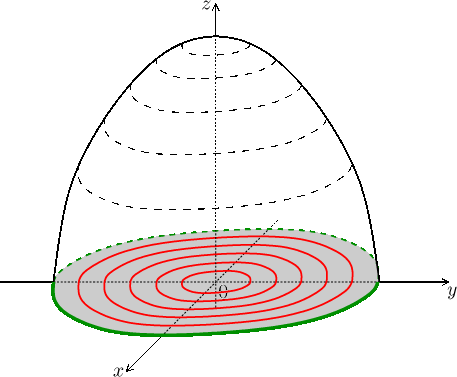
Because the level curves are rotationally symmetric with respect to the origin (they are circles), we can deduce that the graph is also symmetric with respect to rotation about the z-axis.
Now we look at slices. If we fix
![]()
this has
an upper half-circle as its graph. For other fixed
![]()
So this is how cuts using vertical planes parallel to the y-axis look like.
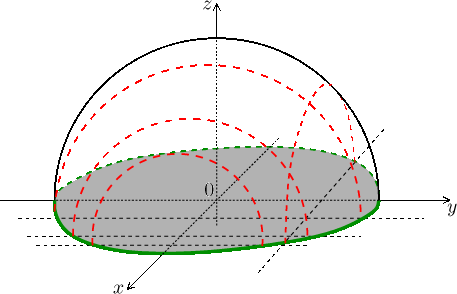
It also works symmetrically, so vertical slices through the graph of f parallel to the x-axis are upper half-circles as well. It would seem that this graph is not just any hill, but a hill of spherical shape.
We try to confirm this guess by recognizing the shape. The graph of f is given by the equation
![]()
which we readily rewrite as
Conclusion: The graph of f is the upper half-sphere (a dome).
Example.
Now we look at the function
f (x, y) = x2 + y2.
Level curves:
Slices: If we choose
When we put this together our observation about rotational symmetry, the conclusion is clear. The graph is a paraboloid, that is, a rotated parabola.
Example.
Now we look at the function
f (x, y) = x2 − y2.
Level curves:
Slices: If we choose
If we choose
Supplemental methods: there is no symmetry of rotation, the equation
Conclusion: It is an interesting graph worth drawing.
Functions of more variables: Derivative
Back to Extra - Functions of more variables